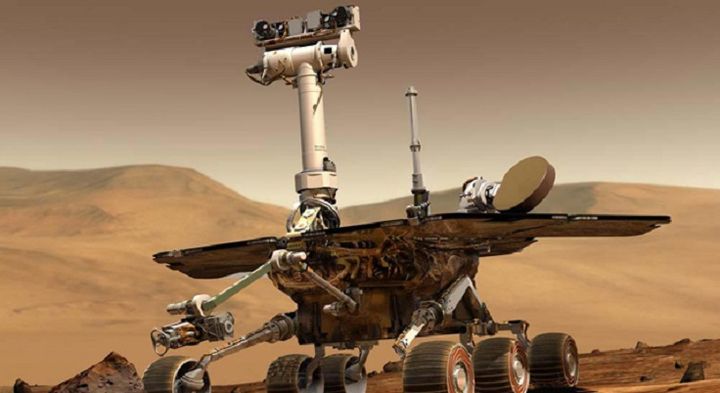
Robotic rovers have provided space exploration with a wealth of information and discoveries in the past few years. Between Curiosity uncovering definitive proof that Mars once had liquid water on its surface, the discovery of organic molecules (which indicate that it may have also supported life at one time), and Opportunity surveying Mars' atmosphere and trekking a total of 42 km (26 miles, the length of a full marathon), there seems to be little these robotic explorers can't do.
Looking to the future, NASA is seeking to get the public involved in the process of creating the next-generation of robotic explorers - machines that will continue to survey Mars, the Moon, and even the outer Solar System someday. Towards this end, they created the Human Exploration Rover Challenge, an annual event hosted by the Marhsall Space Flight Center, where high school and college students come together to design, build, and race human-powered rovers through simulated environments.
Formerly known as the Great Moonbuggy Race, the race was originally inspired by the lunar rovers of the Apollo moon missions that were built by Marshall engineers and scientists. In previous competitions, students designed rovers specifically for lunar exploration and raced them in a simulated lunar environment. The first was held in 1994 and has been an annual event ever since.

Students navigate their rover entry over rocky terrain in the 2014 NASA Human Exploration Rover Challenge. Credit: NASA
However, as of 2014, the competition has expanded to include the exploration of other extra-terrestrial environments, such as Mars, other moons within the Solar System, and even asteroids. This year, the competition will run from April 17th to 18th and will be held at the U.S. Space and Rocket Center in Hunstville, Alabama. Close to 100 high school and college students will be racing against each other, with teams hailing from 15 US states and Puerto Rico, as well as Mexico, Germany, India and Russia.
The nearly 1.2 kilometer (three-quarter mile) obstacle course will have teams racing and maneuvering in, through and around full-size exhibits of rockets, space vehicles and extra-terrestrial terrain currently on display at the U.S. Space & Rocket Center. The event will conclude with an awards ceremony where corporate sponsors will present awards for best design, rookie team and other accomplishments.
One of the greatest aspects of the Challenge, according to Tammy Rowan - the manager of Marshall’s Academic Affairs Office - is the opportunity it gives to students to pit their ideas and abilities against real challenges: "Rover challenge puts students in the driver’s seat of real-world engineering," he said. "Students perform research with computer-aided designs, select and fabricate components using mechanical tools and test their innovative technologies in a wide variety of environments."

Students from Graff Career Center navigate the 360° turn around the course's permanent crater feature. Credit: NASA
This year's course will have the usual lunar-themed obstacles, but will also feature some Martian-themed obstacles that highlight NASA's journey to Mars and other planned deep space exploration missions. The course features a total of 17 unique obstacles- made from wood, aluminum, rubber times, gravel and sand - that are shaped to resemble craters, basins, boulders, ancient lava flows, crevasses, and other things common to extra-terrestrial landscapes.
The course also has simulated fields of asteroid debris - boulders from 13 to 38 centimeters (5 to 15 inches) in diameter, an ancient stream bed filled with pebbles and erosion ruts and crevasses of varying size and depth. This year's challenge will also feature the special "On to Mars" Rover Design Workshop, where students will learn about previous moon and Mars rover missions, break into teams, and come up with their own designs for future Mars rovers.
The race will take place from 7:30 a.m. to 5 p.m. (Central Daylight Time) on April 17th and 18th. The Marshall Space Flight Center's UStream webpage, as well as NASA Telvision and their official Twitter account, will be providing nonstop media coverage and updates from the event. The awards ceremony will take place on April 18th at 5 pm CDT in the Davidson Center for Space Exploration, and will also be broadcast on UStream.

A student team crosses the finish line at last year's Human Exploration Rover Challenge. Credit: NASA/MSFC/Emmett Given
The major corporate sponsors that will presenting awards include Boeing, Lockheed Martin, Northrop Grumman, Aerojet Rocketdyne and Jacobs Engineering ESSSA Group. Institutional contributors include the U.S. Army Aviation and Missile Research Development and Engineering Center, the University of Alabama, the American Institute of Aeronautics and Astronautics, the National Space Club, the National Defense Industrial Association and United Research Services.
Ultimately, the purpose of the competition is to challenge students to solve engineering problems, while also highlighting NASA's commitment to inspiring new generations of scientists, engineers and explorers. In addition, the competition and non-stop media coverage are in keeping with two key aspects of the current era of renewed space exploration - which are public participation and the utilization of social media to promote awareness.
This year's expanded mandate is also a testament to NASA's expanding mandate of exploration, which in the coming years and decades will include surveying an asteroid once it is towed closer to Earth, returning to the Moon to investigate the creation of a permanent lunar settlement, exploring Mars in greater depth, and mounting missions to the Jovians (moons of Jupiter) and Saturn's moons.
For more information, check out the competition page on NASA's website and stay tuned to NASA Television and UStream for updates.

Future exploration missions - to asteroids, distant Moons and comets - will teach us much about the early Solar System and its formation. Credit: National Geographic
Sources:
- www.nasa.gov/roverchallenge/
- www.nasa.gov/content/goddard/mars-organic-matter/
- www.nasa.gov/roverchallenge/teams/index.html#.VRGZYOFFW-c
- www.nasa.gov/roverchallenge/studentschedule/workshop.html#.VQNVoI7F98E
- www.nasa.gov/press/2015/march/nasa-announces-teams-for-2015-human-exploration-rover-challenge/
- www.nasa.gov/press/2015/march/nasas-opportunity-mars-rover-finishes-marathon-clocks-in-at-just-over-11-years/








